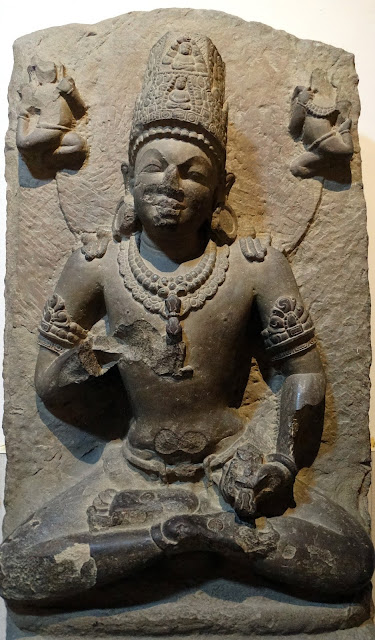11.4.18 In the Last Stretch...
Sarnath, Saris and the Last Supper
This morning we change our focus to the Buddhist religion when we drive to the Buddhist learning center at Sarnath. This is where Gautama Buddha preached his first sermon to his disciples in a location marked by the Indian Buddha and the bodhi tree.
Despite the damage done by the Turks over the years, the Dhamek Stupa, Dharmarajika Stupa, Chaukhandi Stupa and the Ashoka Pillar are preserved among the ruins.
Riding on a Leogriph
(5th century A.D.)
Tara
(11th century A.D.)
Bodhisattva Maitreya
(5th century A.D.)
Image of Kartikeya
(Late Medieval)
And easily the highlight of the museum - besides the Ashoka Pillar -
the 10-armed, bearded, fully-armed with various weaponry
Lord Shiva, killing Andhak, the demon of darkness.
(12th Century CE)
Chamunda, Ganesha & Parvati
(Terrifying Skeletal Deity, Elephant-headed God & Consort of Shiva)
(10th century C.E.)
Sarnath, Saris and the Last Supper
This morning we change our focus to the Buddhist religion when we drive to the Buddhist learning center at Sarnath. This is where Gautama Buddha preached his first sermon to his disciples in a location marked by the Indian Buddha and the bodhi tree.
Dressed for the occasion, Ashish provides
some background information about Gautama Buddha
and the Indian Buddha.
Very nearby, with very obvious differences,
is the Chinese happy Buddha.
Towering over the grounds, at 80 feet high, is India's tallest Grand Buddha statue, unveiled in March 2011, with a joint ceremony by both Thai and Indian leaders.
Despite the damage done by the Turks over the years, the Dhamek Stupa, Dharmarajika Stupa, Chaukhandi Stupa and the Ashoka Pillar are preserved among the ruins.
Dhamek Stupa
Treasures inside the Sarnath Museum...
Ashoka Pillar (about 250 BCE)
Emblem of India since 1950
Buddha in preaching posture.
Riding on a Leogriph
(5th century A.D.)
Tara
(11th century A.D.)
Bodhisattva Maitreya
(5th century A.D.)
Image of Kartikeya
(Late Medieval)
And easily the highlight of the museum - besides the Ashoka Pillar -
the 10-armed, bearded, fully-armed with various weaponry
Lord Shiva, killing Andhak, the demon of darkness.
(12th Century CE)
Chamunda, Ganesha & Parvati
(Terrifying Skeletal Deity, Elephant-headed God & Consort of Shiva)
(10th century C.E.)
Back to the bus for a return to our hotel, but before we depart Ashish conducts our routine bus bazaar, which helps the local vendors and keeps their harassment of us to a minimum. He reminds me of an auctioneer - even though the prices are non-negotiable.
Ashish working his magic...
I love the intent expressions on the faces of the vendors -
hoping their particular item is the one visitors will buy.
The last event before our farewell dinner is modeling saris (I nominated myself as the photographer so I could forgo that opportunity - just not me - go figure...)
Ashish and his harem.





















































